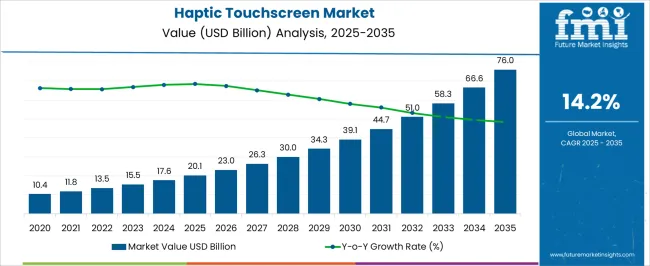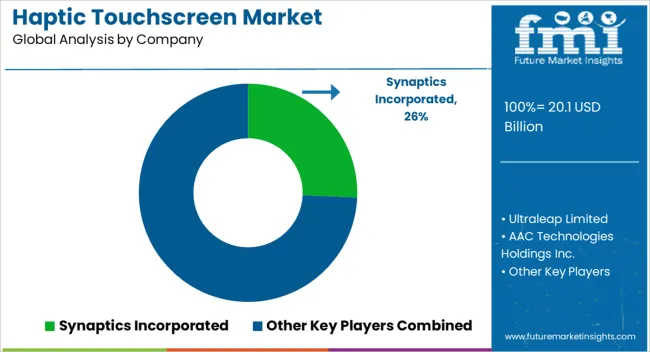The Haptic Touchscreen Market is estimated to be valued at USD 20.1 billion in 2025 and is projected to reach USD 76.0 billion by 2035, registering a compound annual growth rate (CAGR) of 14.2% over the forecast period.

| Metric | Value |
|---|---|
| Haptic Touchscreen Market Estimated Value in (2025 E) | USD 20.1 billion |
| Haptic Touchscreen Market Forecast Value in (2035 F) | USD 76.0 billion |
| Forecast CAGR (2025 to 2035) | 14.2% |
The Haptic Touchscreen market is experiencing robust growth driven by the rising demand for immersive and interactive user experiences across consumer electronics, enterprise applications, and industrial interfaces. The current market environment is shaped by increasing adoption of tactile feedback technologies in devices where intuitive interaction and precision are critical. Advancements in haptic actuator design, multi-touch sensitivity, and software-driven feedback systems have enhanced the usability and responsiveness of touchscreens, making them essential in both consumer and professional contexts.
As mobile devices, tablets, and enterprise touch-enabled applications proliferate globally, demand for haptic solutions continues to expand. Investments in research and development to improve durability, accuracy, and energy efficiency of haptic modules are facilitating market expansion.
The growing need for ergonomically optimized interfaces in corporate environments, alongside rising expectations for enhanced user engagement in mobile devices, is providing sustained growth opportunities Future market potential is further bolstered by increasing integration of haptic touchscreens in collaborative tools, enterprise solutions, and interactive applications, highlighting the technology’s strategic value across industries.
The haptic touchscreen market is segmented by component, application, end users, technology, industry, and geographic regions. By component, haptic touchscreen market is divided into Hardware, Software, and Services. In terms of application, haptic touchscreen market is classified into Mobile Devices, Video Games, Personal Computers, Automated Teller Machines, Tele-Operators And Simulators, Virtual Reality, Ticketing Counters, Robotics, Biometric Devices, Arts, Design And Handwriting, Holographic Interaction, and Others. Based on end users, haptic touchscreen market is segmented into Corporates, Security Departments, Supermarkets And Malls, Educational Institutes, and Others. By technology, haptic touchscreen market is segmented into Contact Haptic Technology and Non-Contact Haptic Technology. By industry, haptic touchscreen market is segmented into Electronics, Robotic, Automobile, Financial, Healthcare, and Others. Regionally, the haptic touchscreen industry is classified into North America, Latin America, Western Europe, Eastern Europe, Balkan & Baltic Countries, Russia & Belarus, Central Asia, East Asia, South Asia & Pacific, and the Middle East & Africa.

The hardware component segment is projected to hold 49.60% of the Haptic Touchscreen market revenue in 2025, making it the leading component type. This dominance is being attributed to the essential role of tactile actuators, sensors, and supporting circuitry in delivering precise haptic feedback. Hardware reliability and sensitivity directly influence user perception, and the ongoing focus on miniaturization and energy-efficient actuators has further driven adoption.
The growth of this segment has been accelerated by the rising integration of haptic modules in mobile devices and corporate interfaces, where performance, durability, and responsiveness are critical. The modular design of haptic hardware allows seamless integration with various touchscreen formats and device sizes, enabling consistent user experiences across applications.
Additionally, hardware improvements have enhanced the compatibility of touchscreens with software-based gesture recognition and adaptive feedback systems As end users increasingly demand more interactive and immersive experiences, the hardware component segment is expected to maintain leadership due to its foundational role in the effectiveness and adoption of haptic touchscreen technology.

The mobile devices application segment is anticipated to account for 42.70% of the Haptic Touchscreen market revenue in 2025, making it the leading application. The prominence of this segment is being driven by the widespread adoption of smartphones, tablets, and wearable devices that prioritize enhanced user interaction and tactile feedback.
Mobile devices benefit from haptic technology through improved typing accuracy, immersive gaming experiences, and gesture-based control, which enhance the overall user interface experience. Growth has been accelerated by consumer preference for premium interactive features and the rising demand for devices that offer intuitive feedback without additional peripherals.
Additionally, the integration of haptic touchscreens into mobile devices supports accessibility features and multi-sensory interaction, increasing their appeal across diverse user demographics As smartphone penetration rises and mobile technology continues to evolve, the mobile devices application segment is expected to sustain its leading position, supported by continuous innovation in haptic feedback mechanisms and consumer expectations for high-quality, interactive touch interfaces.

The corporate end users segment is projected to hold 51.30% of the Haptic Touchscreen market revenue in 2025, establishing it as the leading end-use industry. This dominance is being attributed to the growing deployment of touch-enabled collaborative tools, enterprise devices, and professional control panels where precise interaction is crucial.
Corporates benefit from haptic touchscreens in conference systems, interactive kiosks, point-of-sale devices, and productivity tools, enhancing operational efficiency and user satisfaction. The growth of this segment has been accelerated by the need for ergonomic and responsive touch interfaces that minimize input errors and provide intuitive control.
Additionally, software-driven updates in haptic systems allow corporate installations to remain adaptable and scalable without significant hardware replacement As organizations increasingly invest in interactive workplace technologies and digital transformation initiatives, the corporate segment is expected to continue leading due to the enhanced productivity, employee engagement, and operational advantages provided by haptic touchscreen solutions.
Humans always expect any feedback (something in return) for the stimuli, letting them know that the message was received or not. The same is in the case of the Haptic Touchscreen. Haptic Touchscreen recreates the sense of touch by applying forces, vibrations, or motions to the user. Various haptic displays are becoming available for implementing a new kind of human-computer interaction (HCI) method.
A Haptic Touchscreen finds its frequent application in the mobile phone industry giving significant growth to Haptic Touchscreen Market. Haptic Touchscreen market is witnessing a high growth owing to its increasing applications in several new industries such as medical, ARVR, digital advertising, and others.
Also, several companies in the market are investing in the development of Haptic Touchscreen technologies to introduce better and efficient solutions for enhanced user experience. During the forecast period with the upcoming advanced technologies, Haptic Touchscreen is expected to be used in most of the electronics and optoelectronics devices which give better growth opportunities to the Haptic Touchscreen Market.

| Country | CAGR |
|---|---|
| China | 19.2% |
| India | 17.8% |
| Germany | 16.3% |
| France | 14.9% |
| U.K. | 13.5% |
| U.S. | 12.1% |
| Brazil | 10.7% |
The Haptic Touchscreen Market is expected to register a CAGR of 14.2% during the forecast period, exhibiting varied country level momentum. China leads with the highest CAGR of 19.2%, followed by India at 17.8%. Developed markets such as Germany, France, and the U.K. continue to expand steadily, while the U.S. is likely to grow at consistent rates. Brazil posts the lowest CAGR at 10.7%, yet still underscores a broadly positive trajectory for the global Haptic Touchscreen Market. In 2024, Germany held a dominant revenue in the Western Europe market and is expected to grow with a CAGR of 16.3%. The U.S. Haptic Touchscreen Market is estimated to be valued at USD 7.1 billion in 2025 and is anticipated to reach a valuation of USD 22.3 billion by 2035. Sales are projected to rise at a CAGR of 12.1% over the forecast period between 2025 and 2035. While Japan and South Korea markets are estimated to be valued at USD 961.1 million and USD 536.2 million respectively in 2025.

| Item | Value |
|---|---|
| Quantitative Units | USD 20.1 Billion |
| Component | Hardware, Software, and Services |
| Application | Mobile Devices, Video Games, Personal Computers, Automated Teller Machines, Tele-Operators And Simulators, Virtual Reality, Ticketing Counters, Robotics, Biometric Devices, Arts, Design And Handwriting, Holographic Interaction, and Others |
| End Users | Corporates, Security Departments, Supermarkets And Malls, Educational Institutes, and Others |
| Technology | Contact Haptic Technology and Non-Contact Haptic Technology |
| Industry | Electronics, Robotic, Automobile, Financial, Healthcare, and Others |
| Regions Covered | North America, Europe, Asia-Pacific, Latin America, Middle East & Africa |
| Country Covered | United States, Canada, Germany, France, United Kingdom, China, Japan, India, Brazil, South Africa |
| Key Companies Profiled | Synaptics Incorporated, Ultraleap Limited, AAC Technologies Holdings Inc., Qualcomm Technologies, Inc., Immersion Corporation, TDK Corporation, AAC Technologies, Haption, Apple Inc., Delta Electronics, GoerTek Inc., and Rivian Automotive, Inc. |
The global haptic touchscreen market is estimated to be valued at USD 20.1 billion in 2025.
The market size for the haptic touchscreen market is projected to reach USD 76.0 billion by 2035.
The haptic touchscreen market is expected to grow at a 14.2% CAGR between 2025 and 2035.
The key product types in haptic touchscreen market are hardware, software and services.
In terms of application, mobile devices segment to command 42.7% share in the haptic touchscreen market in 2025.






Our Research Products

The "Full Research Suite" delivers actionable market intel, deep dives on markets or technologies, so clients act faster, cut risk, and unlock growth.

The Leaderboard benchmarks and ranks top vendors, classifying them as Established Leaders, Leading Challengers, or Disruptors & Challengers.

Locates where complements amplify value and substitutes erode it, forecasting net impact by horizon

We deliver granular, decision-grade intel: market sizing, 5-year forecasts, pricing, adoption, usage, revenue, and operational KPIs—plus competitor tracking, regulation, and value chains—across 60 countries broadly.

Spot the shifts before they hit your P&L. We track inflection points, adoption curves, pricing moves, and ecosystem plays to show where demand is heading, why it is changing, and what to do next across high-growth markets and disruptive tech

Real-time reads of user behavior. We track shifting priorities, perceptions of today’s and next-gen services, and provider experience, then pace how fast tech moves from trial to adoption, blending buyer, consumer, and channel inputs with social signals (#WhySwitch, #UX).

Partner with our analyst team to build a custom report designed around your business priorities. From analysing market trends to assessing competitors or crafting bespoke datasets, we tailor insights to your needs.
Supplier Intelligence
Discovery & Profiling
Capacity & Footprint
Performance & Risk
Compliance & Governance
Commercial Readiness
Who Supplies Whom
Scorecards & Shortlists
Playbooks & Docs
Category Intelligence
Definition & Scope
Demand & Use Cases
Cost Drivers
Market Structure
Supply Chain Map
Trade & Policy
Operating Norms
Deliverables
Buyer Intelligence
Account Basics
Spend & Scope
Procurement Model
Vendor Requirements
Terms & Policies
Entry Strategy
Pain Points & Triggers
Outputs
Pricing Analysis
Benchmarks
Trends
Should-Cost
Indexation
Landed Cost
Commercial Terms
Deliverables
Brand Analysis
Positioning & Value Prop
Share & Presence
Customer Evidence
Go-to-Market
Digital & Reputation
Compliance & Trust
KPIs & Gaps
Outputs
Full Research Suite comprises of:
Market outlook & trends analysis
Interviews & case studies
Strategic recommendations
Vendor profiles & capabilities analysis
5-year forecasts
8 regions and 60+ country-level data splits
Market segment data splits
12 months of continuous data updates
DELIVERED AS:
PDF EXCEL ONLINE
Touchscreen Controller Market Growth - Trends & Outlook 2025 to 2035
Touchscreen Gloves Market
Capacitive Touchscreen Market Insights – Growth & Forecast through 2034

Thank you!
You will receive an email from our Business Development Manager. Please be sure to check your SPAM/JUNK folder too.
Chat With
MaRIA